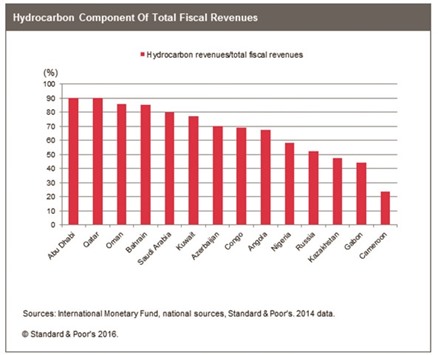Qatar, Kuwait, and Abu Dhabi stand out as having the “most robust stock” of assets, sufficient to “withstand” prolonged periods of lower revenues, Standard & Poor’s has said in a report in which the rating agency has explained why it has not downgraded all the oil exporters.
“We considered available fiscal buffers, the depth of fiscal responses, and an economy’s ability to adjust to price-related shocks,” S&P said.
S&P recently reviewed its sovereign ratings on hydrocarbon exporters after it lowered its assumptions on the development of oil prices over 2016-2018, and beyond, by an annual average of 30%.
“Oil prices can affect a hydrocarbon exporter’s sovereign credit rating due to the role hydrocarbons play in a country’s GDP; the way government revenues are affected; and how lower oil export receipts impact balance-of-payments and net international investment positions (IIPs). We also consider available fiscal buffers, the depth of fiscal responses, and an economy’s ability to adjust to oil price-related shocks,” S&P said.
As a result, the rating agency has downgraded several oil-dependent sovereigns including three from the GCC (Gulf Cooperation Council) region - Saudi Arabia to ‘A-/A-2’ from ‘A+/A-1’; Oman to ‘BBB-/A-3’ from ‘BBB+/A-2’ and Bahrain to ‘BB/B’ from ‘BBB-/A-3’.
S&P said its ratings reflect forward-looking assumptions on oil prices. On January 12, 2016, it updated its assumptions on the development of oil prices over 2016-2018 and beyond.
For Brent crude, most commonly used in S&P sovereign ratings, it lowered its price expectations for 2016 by $15 a barrel and by $20 for 2017 and beyond.
“We think lower prices will now persist for longer than we had previously expected,” S&P said.
The rating agency’s revised near-term oil and natural gas prices chiefly reflect its assessment of the shift in futures price curves.
“We base our long-term price assumptions mostly on the marginal cost of oil and gas production. Our revised long-term price assumptions reflect our belief that these marginal production costs have declined due to improved drilling efficiencies and cost reductions, especially in US shale formations.” Drillers, forced to improvise because of the low prices, have introduced new drilling, fracking, and well-completion techniques that have resulted in more permanent cost reductions.
The oil market also remains oversupplied and will likely remain so through most of 2016. Global oil production still outweighs demand and the resulting increases in crude and product inventories are placing spot and near-term futures under significant pressure.
Primarily, S&P said, it looks at the contribution hydrocarbons make to a country’s GDP, the effect lower oil prices have on government revenues derived from oil sales and the effect of lower oil export receipts on a country’s balance of payment and net IIP.
“We also look at a government’s or economy’s capacity to absorb such shocks. We assess available fiscal and external buffers - including the stock of available assets - and the government’s willingness and ability to reduce spending to offset lower revenues and existing levels of indebtedness.
While hydrocarbons contributed 40%-65% to most Gulf Cooperation Council (GCC) countries’ GDP before the sharp drop in oil prices, at the same time their dependence on exports and fiscal revenues was much higher,” S&P said.

..


